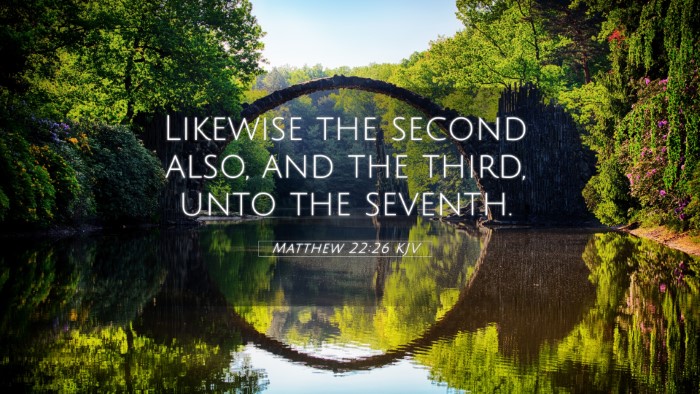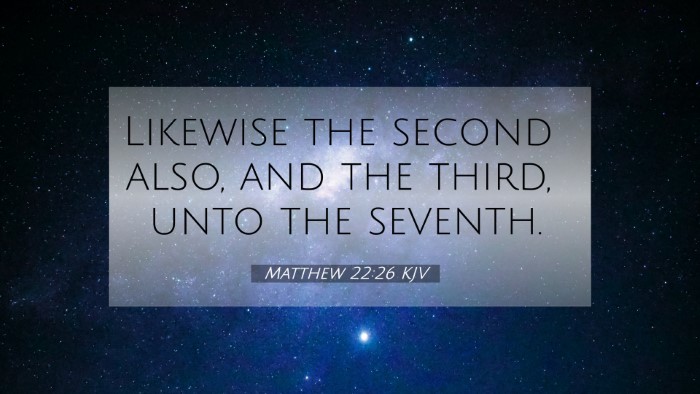Understanding Matthew 22:26
Matthew 22:26 states:
"Likewise the second also, and the third, unto the seventh."
This verse is part of a larger argument presented by the Sadducees, who were attempting to challenge Jesus' teachings on the resurrection. Below is an analysis of the verse's meaning drawn from public domain commentaries including those by Matthew Henry, Albert Barnes, and Adam Clarke.
Summary of Interpretations
Contextual Overview
In this passage, the Sadducees present a hypothetical scenario regarding levirate marriage, a Jewish law outlined in Deuteronomy 25:5-10. They use this scenario to argue against the belief in resurrection, suggesting that if a woman is married to multiple brothers consecutively, whose wife will she be in the resurrection?
Matthew Henry's Commentary
Matthew Henry points out that the Sadducees’ approach highlights their misunderstanding of both the law and the power of God. They believe their logic can undermine Jesus’ claim of resurrection, but in reality, they fail to grasp God's sovereignty over life and death. Henry emphasizes that Jesus later responds to their inquiry by clarifying the nature of the resurrection, indicating that earthly relationships do not continue beyond life.
Albert Barnes' Perspective
Albert Barnes highlights the absurdity of the Sadducees' logic. In presenting their scenario, they unintentionally reveal their own ignorance regarding spiritual matters. He argues that their focus on the mechanical workings of law misses the essence of the resurrection and the life to come. Barnes notes the importance of understanding scripture in its entirety, suggesting that a lack of faith leads to misinterpretation.
Adam Clarke’s Insights
Adam Clarke interprets this verse within the broader context of resurrection belief. He asserts that the Sadducees illustrate a critical theological naiveté by prioritizing human logic over divine revelation. Clarke insists that true understanding comes not from human constructs but from faith in God’s power. Clarke emphasizes the transitional nature of relationships in the resurrection, presenting a view of a transcendent existence beyond earthly constraints.
Cross References and Thematic Connections
This verse connects with numerous other scriptures that deepen our understanding of resurrection and God's promises. Here are cross-references that can be examined:
- Deuteronomy 25:5-10 - The law regarding levirate marriage, providing the background for the Sadducees' question.
- Matthew 22:29-30 - Jesus' response to the Sadducees, emphasizing the nature of the resurrection.
- Mark 12:25 - A parallel account of the same interaction, highlighting the teaching on resurrection.
- Luke 20:34-36 - Another synoptic account that explains the parameters of relationships in the age to come.
- John 5:28-29 - A teaching on the resurrection of the dead and the judgment that follows.
- 1 Corinthians 15:12-22 - Paul's discourse on resurrection, affirming its central importance in Christian theology.
- Revelation 21:4 - A vision of the future where death and pain are vanquished, providing hope for eternal life.
Thematic Bible Verse Connections
Matthew 22:26 serves as a critical juncture for understanding numerous themes in the Bible, particularly concerning resurrection. Key themes include:
- Resurrection of the dead
- Divine authority over human tradition
- The nature of eternal life
- Faith versus human reasoning
Guidance for Bible Study and Cross-Referencing
Utilizing tools for cross-referencing Bible verses is essential for deeper study. Here are practical tips:
- Utilize a Bible Concordance: A concordance allows you to locate passages and concepts quickly.
- Employ a Bible Cross-Reference Guide: These guides help connect similar verses throughout the scripture.
- Conduct Comparative Bible Verse Analysis: This method aids in discovering the interplay between different scriptures.
- Engage in Cross-Reference Bible Study Methods: Use thematic studies to identify connections between various books of the Bible.
Conclusion
In summary, Matthew 22:26 invites believers to examine the nature of their faith, the concept of resurrection, and the importance of understanding Scripture as a cohesive narrative. Cross-referencing related Bible verses enriches one’s comprehension and appreciation of the biblical text, revealing profound truths about God’s design for humanity. By engaging with these teachings through a lens of faith, one can cultivate a deeper relationship with God and greater insight into His Word.


